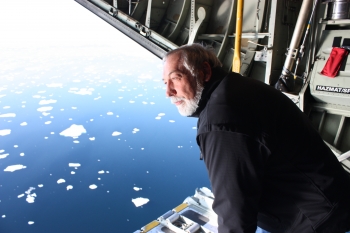Arctic Facts, Thoughts, and Movement Forward

The Arctic encompasses far more than the assumption that the Arctic is everything north of the Arctic Circle (66˚ 30' N Latitude). In fact, there are many other definitions of the Arctic. Some prefer to define the Arctic as those areas where the average July temperature is 10 ˚C or less, or the presence of continuous permafrost as opposed to the discontinuous permafrost found in the sub-Arctic, or even those areas lying north of the tree line. Yet another definition, specific to the United States, is found in the Arctic Research and Policy Act of 1984, as amended: the U.S. Arctic includes all the U.S. territory north and west of the boundary formed by the Porcupine, Yukon and Kuskokwim Rivers; all contiguous seas, including the Arctic Ocean and the Beaufort, Bering and Chukchi Seas; and the Aleutian chain (the Aleutian change boundary is demarcated by the "Contiguous zone" limit of 24-nautical miles). Whichever definition one uses, the Arctic is BIG, roughly twice the size of Australia. (Maps of the Arctic are available here.)
When the first maps of the world were sketched, those regions of the far North were marked with signs of shipwrecked seas, monsters, and bottomless chasms. For several centuries, the far North remained a place of extreme unknown. In the 19th century, the quest for a Northwest Passage became an obsession for Britain, as did the North Pole itself for the United States and other nations later in the century. Then in 1882-83 Adolphus Washington Greely was appointed to lead the United States' contribution to the First International Polar Year. The purpose of Greely's expedition was to establish a series of research stations (along with other nations) to monitor polar conditions. Finally, the quest for knowledge and understanding of the Arctic began in earnest.
Today, for many, the Arctic is a cold, distant place that is captured in photographs and movies as beautiful, remote, and having an abundance of wildlife, but far from their everyday lives. But the scientific quest to gain a better understanding of the Arctic, its Peoples, and the rapid changes taking place in its ice, seas, water, coasts, and terrestrial environments is more important than ever. The increased knowledge of the Arctic gained through research and monitoring is helping us understand the influence the Arctic has on lower latitudes and offers insights in how we must adapt to the challenges compounded by environmental, social, and economic changes.
Researchers questing for more knowledge in the Arctic have always faced competition for limited resources, challenges to scientific integrity, and questions as to why more research is needed. At the same time, extractive, global transportation, and tourism industries are exploring new frontiers. Looking to potentially save hundreds of millions of dollars by shipping across the Arctic instead of the Panama Canal or around South America, companies are navigating the northern passage in the Russian Republic Arctic Ocean, or through the Northwest Passage through Canada, to get to Asia or the west coast of North America with their trade. Multi-national oil and gas companies are expanding their exploration in Arctic waters and on the land. Warning signs of extreme changes in the environment include rising sea levels, more frequent and intense weather in the Arctic, melting permafrost releasing increased levels of methane gas, decreased water availability, and migration of non-indigenous species of fish, wildlife, vegetation and insects as the environment becomes more favorable to their niche. Add pressures of increased tourism, the possible decline of the Native cultures and their lifestyles, and we face serious emotional, political, and financial conflict in the north.
Are we prepared both fiscally and physically for these changes? Partnerships, coalitions, and initiatives now exist that are helping decision and policy makers to utilize new tools (or sometimes refreshing old tools) when planning their mandated activities in the Arctic. We have a very real opportunity to look across the Arctic and share knowledge from other nations. Using the experience of others, and of our own Arctic stakeholders, we can achieve a comprehensive vision of a future Arctic through an integrated process that has broad goals instead of the more traditional single focus. ARCUS supports increased understanding of a changing Arctic by helping to build those strong relationships between diverse stakeholders and disciplines—from researchers to the public, from decision and policy makers to industry. The Arctic is a fascinating and important region, and its importance spans the entire globe. The United States is an Arctic nation; Alaskans are particularly vested because without Alaska the United States would not be an Arctic nation. But the Arctic's reach extends far beyond those of us who live here. Sea ice and glaciers, oil and mineral exploration and development, and the vast ecosystems housed by the Arctic's land and marine spaces all have important implications for the rest of America and the world at large.
Here at ARCUS, we play a neutral, science-based role. We do not advocate for specific policy implementations or play favorites regarding what research or scientific issues get our focus. We rely solely on grants, membership dues, and donations to implement our programs. Now, more than ever before, all of us need to support Arctic research. As President of the Board of Directors for ARCUS, I want to convey my sincere thanks for your support of our programs and efforts to increase our understanding of our Arctic. More information on ARCUS, including how you can join our community or provide support to us, is available through our website.
John F. Payne, Ph.D.
President
